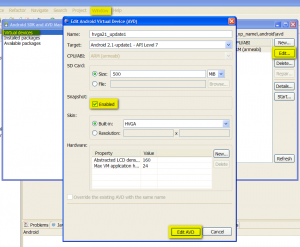findViewById in onCreate returns NULL when using Fragment
Call findViewById from onCreateView
res\layout
activity_main.xml
fragment_main.xml
public class MainActivity extends ActionBarActivity {
@Override
protected void onCreate(Bundle savedInstanceState) {
super.onCreate(savedInstanceState);
setContentView(R.layout.activity_main);
if (savedInstanceState == null) {
getSupportFragmentManager().beginTransaction()
.add(R.id.containerMoje, new PlaceholderFragment()).commit();
}
}
/**
* A placeholder fragment containing a simple view.
*/
public static class PlaceholderFragment extends Fragment {
public PlaceholderFragment() {
}
@Override
public View onCreateView(LayoutInflater inflater, ViewGroup container,
Bundle savedInstanceState) {
View rootView = inflater.inflate(R.layout.fragment_main, container,
false);
if (container == null) {
return null;
}
TextView mText;
mText = (TextView)rootView.findViewById(R.id.idText);
mText.setText("Hello from fragment_main");
return rootView;
}
}
}
res\layout
activity_main.xml
<FrameLayout xmlns:android="//schemas.android.com/apk/res/android"
xmlns:tools="//schemas.android.com/tools"
android:id="@+id/containerMoje"
android:layout_width="match_parent"
android:layout_height="match_parent"
tools:context="cz.okhelp.autoskola.MainActivity"
tools:ignore="MergeRootFrame" />
fragment_main.xml
<RelativeLayout xmlns:android="//schemas.android.com/apk/res/android"
xmlns:tools="//schemas.android.com/tools"
android:layout_width="match_parent"
android:layout_height="match_parent"
android:paddingBottom="@dimen/activity_vertical_margin"
android:paddingLeft="@dimen/activity_horizontal_margin"
android:paddingRight="@dimen/activity_horizontal_margin"
android:paddingTop="@dimen/activity_vertical_margin"
tools:context="cz.okhelp.autoskola.MainActivity$PlaceholderFragment" >
<TextView
android:id="@+id/idText"
android:layout_width="wrap_content"
android:layout_height="wrap_content"
android:text="@string/hello_world" />
</RelativeLayout>
396LW NO topic_id
AD
Další témata ....(Topics)
Update TextView by runnable. Handler, runnable, timer Android example.
main.xml
public class TimerActivity extends Activity {
TextView hTextView;
Button hButton, hButtonStop;
private Handler mHandler = new Handler();
private int nCounter = 0;
@Override
public void onCreate(Bundle savedInstanceState) {
super.onCreate(savedInstanceState);
setContentView(R.layout.main);
hTextView = (TextView)findViewById(R.id.idTextView);
hButton = (Button)findViewById(R.id.idButton);
hButton.setOnClickListener(mButtonStartListener);
hButtonStop = (Button)findViewById(R.id.idButtonStop);
hButtonStop.setOnClickListener(mButtonStopListener);
} // end onCreate
View.OnClickListener mButtonStartListener = new OnClickListener() {
public void onClick(View v) {
try {
mHandler.removeCallbacks(hMyTimeTask);
// Parameters
// r The Runnable that will be executed.
// delayMillis The delay (in milliseconds) until the Runnable will be executed.
mHandler.postDelayed(hMyTimeTask, 1000); // delay 1 second
} catch (Exception e) {
// TODO Auto-generated catch block
e.printStackTrace();
}
}
};
private Runnable hMyTimeTask = new Runnable() {
public void run() {
nCounter++;
hTextView.setText("Hallo from thread counter: " + nCounter);
}
};
/**
*
*/
View.OnClickListener mButtonStopListener = new OnClickListener() {
public void onClick(View v) {
mHandler.removeCallbacks(hMyTimeTask);
}
};
}
main.xml
<?xml version="1.0" encoding="utf-8"?>
<LinearLayout xmlns:android="//schemas.android.com/apk/res/android"
android:orientation="vertical"
android:layout_width="fill_parent"
android:layout_height="fill_parent"
>
<TextView
android:id="@+id/idTextView"
android:layout_width="fill_parent"
android:layout_height="wrap_content"
android:text="@string/hello"
/>
<Button android:text="Button"
android:id="@+id/idButton"
android:layout_width="wrap_content"
android:layout_height="wrap_content"></Button>
<Button android:layout_width="wrap_content"
android:layout_height="wrap_content"
android:id="@+id/idButtonStop"
android:text="Stop"></Button>
</LinearLayout>
BufferedWriter, FileWriter, write, close MODE_APPEND Java and Android example
Write to file Android example
Write to file Java example
Write to file Android example
try {
String MYFILE = "my_file";
String strText = "My text";
// MODE_APPEND, MODE_WORLD_READABLE, MODE_WORLD_WRITEABLE
// create new file or rewrite existing
FileOutputStream fos = openFileOutput(MYFILE, getApplicationContext().MODE_PRIVATE);
// append to file
FileOutputStream fos = openFileOutput(MYFILE, getApplicationContext().MODE_APPEND);
fos.write(strText.getBytes());
fos.close();
} catch (IOException e) {
e.toString();
}
Write to file Java example
try {
// new file
BufferedWriter out = new BufferedWriter(
new FileWriter("outfilename"));
// append text
BufferedWriter out = new BufferedWriter(new FileWriter("outfilename", true));
out.write("some text");
out.close();
} catch (IOException e) {
e.toString();
}
Very very quick start of Android Emulator from Eclipse.
If will closed Android Emulator all data will saved on disk.
If will reopen Android Emulator, configuration and data will read from disk.
[caption id="attachment_768" align="alignleft" width="300" caption="android-emulator-enable-quick-start"] [/caption]
[/caption]
- Go to Eclipse s menu Window -> Android SDK and AVD Manager
- Select Virtual devices
- Select check box Snapshot: Enabled
- Press Edit AVD button.
If will closed Android Emulator all data will saved on disk.
If will reopen Android Emulator, configuration and data will read from disk.
[caption id="attachment_768" align="alignleft" width="300" caption="android-emulator-enable-quick-start"]
 [/caption]
[/caption]Where file(s) does eclipse store Java code style settings to?
If you need copy any old templates to the new workspace.
You can edit the Eclipse Templates from menu Window - Preferences - Java - Editor - Templates.
If you need copy any old templates to the new workspace.
workspace\.metadata\.plugins\org.eclipse.core.runtime\.settings\org.eclipse.jdt.ui.prefs
You can edit the Eclipse Templates from menu Window - Preferences - Java - Editor - Templates.
Add and shuffle elements in LinkedList or ArrayList Java basic example.
import java.util.Collections;
import java.util.LinkedList;
import java.util.List;
public class MainClass {
public static void main(String[] arg) {
String[] arrayOfString = {"nothing", "Hello", "people"
, "bye-bye", "hello", "world!", "End" };
List<String> arrayList = new LinkedList<String>();
for(String s: arrayOfString)
arrayList.add(s);
Collections.shuffle(arrayList);
System.out.println(arrayList);
}
}
/*
[hello, world!, bye-bye, nothing, people, End, Hello]
*/
Editace: 2014-07-12 13:48:55
Počet článků v kategorii: 396
Url:findviewbyid-in-oncreate-returns-null-when-using-fragment



